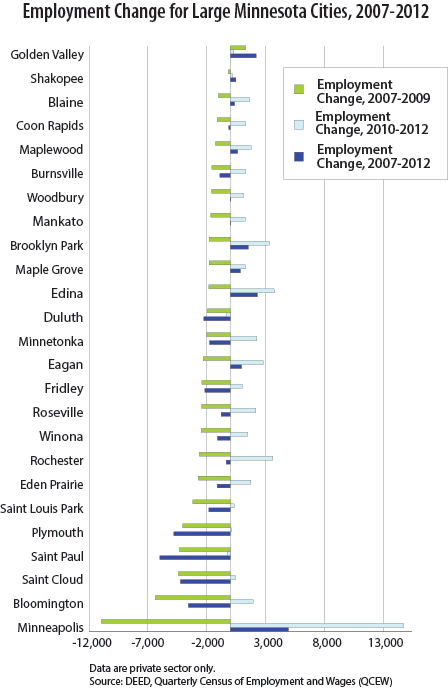by Rachel Vilsack
December 2013
While Minnesota has recovered all the jobs that were lost in the recession, many of the state’s largest cities remain below their pre-recessionary employment levels.
Four years after the end of the Great Recession, Minnesota has regained all the private-sector jobs that were lost in the recession. But while the broad numbers are positive, the state’s largest cities have fared differently. Some cities have recovered all their jobs, while others haven’t.
Figure 1 displays private-sector employment changes for 25 Minnesota cities with the largest employment. Only one city (Golden Valley) suffered no job losses during the recession between 2007 and 2009. In fact, employment in Golden Valley increased each year between 2007 and 2011, before seeing a 1.3 percent decline in employment between 2011 and 2012.

Of the 24 large Minnesota cities that experienced job losses during the recession, nine have fully recovered, pushing their annual average employment in 2012 to above their 2007 levels. Most notable is Minneapolis, which lost 10,955 private-sector jobs (a decline of 4.4 percent) between 2007 and 2009, only to regain 14,713 jobs between 2010 and 2012. In total, private employment levels in Minneapolis in 2012 exceeded the city’s 2007 employment level by 4,938 jobs.
One trend may separate the post-recessionary success of large Minnesota cities from other small- to mid-sized cities: growth in the years immediately following the recession. Only two cities (Duluth and St. Paul) had continued employment declines between 2010 and 2012.
But for those cities that gained employment between 2010 and 2012, it may not have been enough to get back to pre-recessionary employment levels. Table 1 shows the job losses during the recession and subsequent gains by cities with 2012 employment averages above their 2007 employment levels. All of these cities are within the seven-county Twin Cities region.
| Cities With Job Growth Between 2007 and 2012 | |||
|---|---|---|---|
| - | Job Loss 2007-2009 | Job Gains 2010-2012 | Job Gains 2007-2012 |
| Minneapolis | -10,995 | 14,713 | 4,938 |
| Edina | -1,817 | 3,728 | 2,308 |
| Golden Valley | 1,297 | 295 | 2,195 |
| Brooklyn Park | -1,790 | 3,304 | 1,532 |
| Eagan | -2,304 | 2,781 | 958 |
| Maple Grove | -1,806 | 1,279 | 858 |
| Maplewood | -1,258 | 1,771 | 626 |
| Shakopee | -164 | 188 | 480 |
| Blaine | -1,011 | 1,624 | 362 |
| Woodbury | -1,585 | 1,128 | 44 |
| Data are private sector only. Source: DEED, Quarterly Census of Employment and Wages (QCEW) | |||
Of cities in Greater Minnesota, Mankato had only 22 fewer private-sector jobs in 2012 than in 2007. Jobs in Rochester (-354), Winona (-1,096), Duluth (-2,161), and St. Cloud (-4,238) were also off from their higher 2007 employment levels. It's St. Paul, however, that has the most ground to make up, needing to gain back 5,989 jobs before reaching pre-recessionary employment levels.
Recovery is still underway in more than half of Minnesota's largest cities, which hadn't recovered from their recessionary job losses by 2012.
The central cities of Minneapolis and St. Paul deserve their own attention, as their recessionary and post-recessionary trends have deviated. Both cities witnessed job loss between 2007 and 2009. Minneapolis lost a larger number of jobs and a larger share of private-sector employment than St. Paul, which lost 4,332 jobs, a decline of 3 percent.
While employment in St. Paul continued to decline in 2010, increased slightly in 2011 and declined again in 2012, employment in Minneapolis increased each year since 2009.